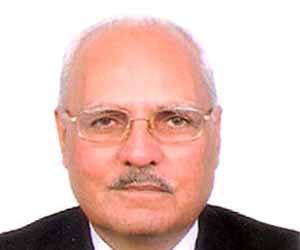India is in transition in many ways: From agricultural to industrial to information age with constantly varying coincidence amongst them. There is transformation to digital economy, new tax regime, infrastructure development and extension of services to empower the common citizen as part of ‘Digital India’ programme, establishing an indigenous industrial base as part of ‘Make in India’ and so on. Most of these are work in progress and that calls for very focused and astute management of change, particularly related to the aspirations of the people and implementation on ground. These can be exploited by people/forces hostile to India with direct impact on national security - particularly in the prevailing geo-political and internal environments.
Due to the widespread deployment of Information and Communication Technologies (ICT) and Media, the transition from industrial to communication spheres has been extremely fast and a large number of people in agricultural age have catapulted straight into the information age. A billion plus mobile phones, second largest users of internet in the world with global connectivity, vibrant social, electronic and printed media have created a very dynamic Information Environment (IE) and awareness which present a great challenge to governance and national security - and this needs to be taken note of. Rumours, fake news and post-truth have become critical components of our digital existence, challenging the very basics of rationality, logic and objective thinking.
The information regime the world over is getting disrupted. The pace and reach of information is mindboggling. While the ease of communications has brought immense benefits, it has also given rise to a different security regime, challenged the very concept of sovereignty, ushered a new wave of crime with direct impact on human security and privacy. Worse still, it has entered the cognitive domain wherein the habits, profiles, values, aspirations, ambition, cultural and religious aspects can be exploited with detrimental effects on governance and national security. It has also become a very potent tool for radicalization and terrorism. Forces inimical to India, both internal and external, are exploiting the IE through rumours, fake news and post-truth as part of a larger design of ‘Social Engineering’ and deployment of ‘Persuasive Technology’. As more people come online, the threat would increase exponentially with enhanced vulnerability and consequent challenge to national security.
Rumours and fake news are akin to Improvised Explosive Devices (IEDs) in the information domain: Low cost and easy availability of technology means they can be launched anywhere with primitive delivery mechanism and yet they are capable of creating substantial damage. The threat is widespread, complex and resource intensive to defend against since the surprise element is with the initiator. These are threats of serious concern. A different kind of war is being waged against India 24/7, specially targeting our diversity, differential development, disturbed areas and the very concept of democracy.
The nation is entering a very critical period with the forthcoming elections and related activities. We will face interventions both from internal and external sources and must be ready and proactive in controlling the exploitation of social and other media. For these to happen, exchange of information within the country as also with friendly countries is a vital pre-requisite and must be ensured through appropriate legislation in the country and diplomatic parleys.
Electronic interventions happen at the speed of light and hence any physical measure in combating this threat would fail. Since, information is the sword and also the shield, we will have to deploy technology and exploit information through synergetic approach with innovation, out of box measures, active involvement of the youth, judicious employment of millennials and qualified resource persons. Intelligence agencies will have to work together and sharpen the procedures and processes for quick action in consultation with Law Enforcement Agencies (LEAs) and launch counter offensives.
There is an immediate requirement of Information Management Agency and Threat Research and Forecast Organisations. These must be capable of making available integrated teams to counter social engineering interventions and should comprise civil agencies, service providers, platforms, industry, academic and R&D representatives as members. The Civil Defence set up must be re-energised with formation of multi-lingual ‘information wings’ in different regions with robust and high capacity connectivity and manned by qualified people in requisite fields who would be required to constantly monitor the information environment and work in close coordination with CERT-In.
Information management has three aspects namely code, content and control. We would need capabilities in each of these to be able to successfully combat the evil aspects of social engineering and associated platforms. This requires collaboration, coordination and complete synergy. Take the example of the recent unfortunate incidences of lynching. The Content (information) was created as a rumour, was processed and transported on internet and social media by employing Code (computer software) and Control was exercised to ensure its wide and speedy reach, creation of mob frenzy and chaos terminating in physical action to kill. All this, barring the physical assault, happens at the speed of light. Any manual system would be reactive and not effective since the fire would have spread beyond control by that time. Our law enforcement agencies will have to operate at the coincidence of code and control. They would remain relevant there and hence must be trained and equipped accordingly, backed by appropriate technology and infrastructure.
The Threat Research and Forecast Organisation would be a multi-specialty and fully integrated set up consisting of technical experts, social scientists, psychologists, behavior experts, historians, civil society, legal, intelligence, law enforcement and religious representatives. It would be responsible to conduct research in the social engineering, persuasive and behavioral technologies. It would continuously monitor the information environment, recognise and analyse the threat, and carry out simulations on the likely effect that may be caused by an event. It would then share the information with all concerned and suggest possible preventive measures so as to be proactive and develop content to counter possible threats.
Some of the measures which could be adopted to limit the propagation of fake news and propaganda are listed below:-
- The ‘Common Facility Centres’ created under Digital India programme, panchayats, rural banks, police stations and post offices be used to provide correct news and curb rumors.
- All party ‘Information Dissemination’ nodes be created with broad band connectivity to feed correct news to organisations mentioned above.
- Service providers, platforms and the private sector must be sensitised to have self-control and be a part of this exercise as it concerns both the national and individual security.
- Electronic media and Radio should be taken into confidence and requested to play a prominent role in furtherance of national security by total transparency and halting the spread of fake news and rumours.
- Press Council of India and Press Trust of India should be taken in confidence for projecting correct news in the print media and should display self-control.
- Information Nodes for creating and transporting content in all languages and for different audiences, should be formed at regional levels and the information be shared with selected people before release. Special packages for J&K and Naxal affected areas would be needed and responded to in real time.
- Religious leaders must be requested to be a part of ‘Sarva Dharam Bharat’ Movement and educate the masses on the unity of man and the Indian State.
- An information campaign should be launched to prove the efficacy and accuracy of voting machines and generate the confidence amongst the masses.
- Involvement of the youth in this critical time, emphasising the role they must play in ensuring the security and unity of the nation.
- All youth organisations like National Cadet Corps, Auxiliary Cadet Corps, National Service Scheme, Police Cadets etc. should be made ready for deployment. They must be trained in crowd control, traffic management and most of all to effectively promote the idea of India and ensure her unity, security and sovereignty. They must also be trained and deployed to educate the masses to shun fake news and not be carried away by rumours.
- India has the largest number of Bots in the world. There are social bots that are “malicious entities designed specifically with the purpose to harm. These bots mislead, exploit, and manipulate social media discourse with rumors, spam, malware, misinformation, slander, or even just noise. This information can distort election campaigns, affect public perceptions, or shape human emotions. Indian Government has launched a special programme to locate Bots and neutralise them. This would need expediting and special attention.
Challenges of Regulation
Fake news and sophisticated disinformation campaigns are especially problematic in democratic systems, and there is growing debate on how to address these issues without undermining the benefits of digital media and violating the provisions of liberty and freedom of expression as enshrined in our Constitution. These present formidable challenges, particularly after the deletion of Article 66 A of the I T Act by the Honourable Supreme Court, and the sheer numbers of people using media outlets by way of platforms like Facebook, Twitter, and WhatsApp and so on; besides over 800 TV channels and 105,443 (as in 2015) newspapers registered in India. Hence, impact of any regulation is going to be limited. Self-control, transparency and awareness coupled with trust seem to be the answer.
Identifying fake news and preventing the propagation of the same is definitely a responsibility area for most news rooms. During these times of fast-paced news, media organisations have to look inwards and be aware of the moral responsibility that rests on their shoulders. Noticing the increasing instances of fake news in various mediums including print and electronic media, the Government has amended the Guidelines for Accreditation of Journalists. The Press Council of India and the News Broadcasters Association, industry bodies that are supposed to oversee self-regulation, already had guidelines that covered “accuracy and fairness”. However, the larger question as to “What is fake news” remains unresolved.
Decline in public trust in media is dangerous for democracies. With the current political situation in a state of great flux in India and around the world, there are questions concerning the quality of the information available to the general public and the impact of marginal media organisations on voter assessments. These developments have complicated the manner in which people hold leaders accountable and the way in which our political system operates. Stated frankly, everyone has a responsibility to combat the scourge of fake news. This ranges from supporting investigative journalism, reducing financial incentives for fake news, and improving digital literacy among the general public.
One sees some activity in these areas and gets an impression that the Government is aware of the looming threat. That is a good sign. The threat is real, very potent and is likely to increase exponentially. There is a lot to be done, the time is short and the enemy is both within and without. Cognitive, virtual and physical aspects of IE would have to be taken into account in real time and responded to. Immediate forming of the above mentioned organisations is both a critical and essential requirement. India is at war of a different kind, threatening governance, national and individual security. We have to respond to that with strong resolve, unity and informed citizens and with both soft and hard power across the full spectrum.
(The paper is the author’s individual scholastic articulation. The author certifies that the article/paper is original in content, unpublished and it has not been submitted for publication/web upload elsewhere, and that the facts and figures quoted are duly referenced, as needed, and are believed to be correct). (The paper does not necessarily represent the organisational stance... More >>
Image Source: http://www.visualcapitalist.com/wp-content/uploads/2017/05/fighting-fake-news-share.jpg










Post new comment